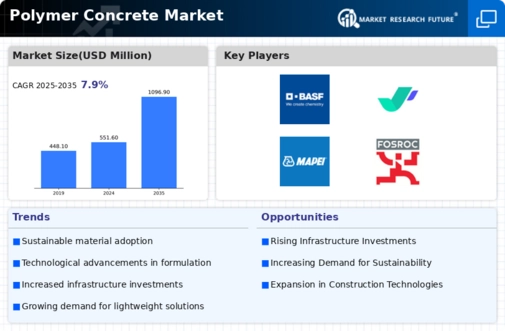Market Growth Projections
The Global Polymer Concrete Market Industry is projected to experience substantial growth over the next decade. With an anticipated market value of 551.6 USD Million in 2024, the industry is set to expand significantly, reaching approximately 1,096.9 USD Million by 2035. This growth trajectory indicates a compound annual growth rate of 6.45% from 2025 to 2035. Such projections reflect the increasing adoption of polymer concrete across various sectors, driven by its unique properties and the rising demand for durable and sustainable construction materials. The market's evolution suggests a promising future for polymer concrete in the global construction landscape.
Environmental Sustainability Initiatives
Environmental sustainability initiatives significantly influence the Global Polymer Concrete Market Industry. As global awareness of environmental issues increases, the construction industry is shifting towards more sustainable practices. Polymer concrete, which can incorporate recycled materials and reduce waste, aligns with these sustainability goals. Furthermore, its energy-efficient production processes contribute to lower carbon footprints compared to traditional concrete. This alignment with environmental standards not only enhances the appeal of polymer concrete but also encourages its adoption in various construction projects. Consequently, the market is expected to grow as more stakeholders prioritize sustainability in their material choices.
Growing Awareness of Polymer Concrete Benefits
Growing awareness of the benefits of polymer concrete is driving the Global Polymer Concrete Market Industry forward. Stakeholders in the construction sector are increasingly recognizing the advantages of polymer concrete, such as its resistance to moisture, chemicals, and temperature fluctuations. This awareness is particularly pronounced among engineers and architects who seek innovative solutions for challenging construction environments. As educational initiatives and industry collaborations promote the use of polymer concrete, its adoption is likely to increase. This trend may lead to a more robust market presence, further solidifying polymer concrete's role in modern construction practices.
Increasing Infrastructure Development Projects
The Global Polymer Concrete Market Industry benefits from the increasing number of infrastructure development projects worldwide. Governments and private sectors are investing heavily in infrastructure to support economic growth and urbanization. Polymer concrete's unique properties, such as rapid curing times and high durability, make it an ideal material for various applications, including roads, bridges, and precast elements. This trend is particularly evident in developing regions, where infrastructure needs are escalating. As the market evolves, it is anticipated that the demand for polymer concrete will rise, contributing to a projected market value of 1,096.9 USD Million by 2035.
Technological Advancements in Polymer Concrete
Technological advancements play a pivotal role in shaping the Global Polymer Concrete Market Industry. Innovations in formulation and application techniques enhance the performance characteristics of polymer concrete, making it more appealing for various construction applications. For instance, the development of high-performance polymer resins allows for improved bonding and curing processes, which can lead to faster project completion times. These advancements not only improve the material's properties but also contribute to cost-effectiveness in construction. As a result, the market is poised for growth, with projections indicating a compound annual growth rate of 6.45% from 2025 to 2035.
Rising Demand for Durable Construction Materials
The Global Polymer Concrete Market Industry experiences a notable surge in demand for durable construction materials, driven by the need for longevity and resilience in infrastructure projects. As urbanization accelerates, the construction sector increasingly seeks materials that can withstand harsh environmental conditions. Polymer concrete, known for its superior strength and resistance to chemicals, emerges as a preferred choice. In 2024, the market is projected to reach 551.6 USD Million, reflecting a growing recognition of polymer concrete's benefits in enhancing the lifespan of structures. This trend is likely to continue, with the market expected to expand significantly in the coming years.














